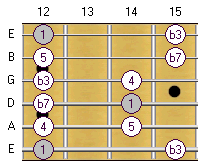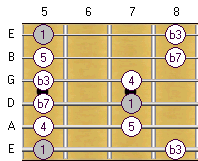One of the essential things to learn if you’re new to guitar scales is how to move various scale fingerings to different keys. Understanding how to do this will allow you to use any scale you know in a wider range of musical settings. (If you can only play a scale in one key, then you’re going to be extremely limited in your soloing versatility!).
The good news is that it’s actually pretty easy to learn. So let’s get started by looking at a thing called root notes…
Understanding Root Notes
Check out the table below which shows the notes of the E Minor Pentatonic scale…

For this lesson, the most important note to focus on is the note E. This note is the first note of the E Minor Pentatonic scale, and is often referred to as the root note. It’s very important to know that the first note (1) of any scale is always the root note. So that would mean…
- The root note of the A Minor Pentatonic scale is the note A.
- The root note of the D Minor Pentatonic scale is the note D.
- The root note of the G Minor Pentatonic scale is the note G.
I’ll stop there. I’m sure you get the idea. 🙂
Now that we’ve talked a little bit about root notes, let’s now take a look at the first fingering of the E Minor Pentatonic scale…
Analysing Fingering 1 Of The E Minor Pentatonic 1
E Minor Pentatonic Scale: Fingering 1

If you look closely at the fretboard diagram above, you might notice a few interesting things…
- There is a root note (1) located at the 12th fret on the thick E-string.
- There is a root note located at the 14th fret on the D-string.
- There is a root note located at the 12th fret on the thin E-string.
Knowing the locations of the root notes within a scale fingering is essential to know. So make sure that when you learn guitar scales, memorize where the root notes are. You’ll thank me later! 🙂
Moving The Scale Fingering To Different Keys
Once you know where the root notes are in the scale fingering, then it’s really easy to move it to new keys. All you need to do is move the root notes of the scale fingering so that they are now on the note of the key that you want to play.
For Example: If we wanted to move the first fingering of the minor pentatonic scale to the key of A, we would move the fingering so that the root notes are now on the note A…
If you check out this diagram closely, you’ll notice that all the root notes of the fingering are now are on A notes. So if you were to play through the fingering in this location, that would mean you are now playing the A Minor Pentatonic scale.
If what I’ve written here is not clear enough, I really recommend watching the video below. It’s hard to describe some of this stuff with text only, and the video will allow you to see and hear what I’m trying to explain…
An Exercise For You To Do
OK, now it’s time for you to do an exercise that will help you get comfortable with moving the first fingering of the minor pentatonic scale to new keys. Please do the following now…
Step 1: Play the first fingering of the E Minor Pentatonic scale.
Step 2: Move the same fingering to the right place to play the A Minor Pentatonic scale.
Step 3: Play through the scale fingering to hear what it sounds like in the new key.
Step 4: Repeat Step 2 and Step 3 for the following keys…
- D Minor Pentatonic.
- G Minor Pentatonic.
- C Minor Pentatonic.
- F Minor Pentatonic.
- Bb Minor Pentatonic.
- Eb Minor Pentatonic.
- Ab Minor Pentatonic.
- Db Minor Pentatonic.
- Gb Minor Pentatonic.
- B Minor Pentatonic.
Step 5: To finish the exercise, play the first fingering of the E Minor Pentatonic scale again.
A Few Last Words
Even though we focused on fingering one of the minor pentatonic scale in this lesson, it’s important to realize that what we’ve talked about applies to all scale fingerings. In other words, to move any scale fingering to a new key, you need to take the following three steps…
- Find where the root notes are in the scale fingering.
- Move the root notes until they are on the note of the new key that you want to play.
- Play the scale fingering in the new location.
Practice hard!
Return To: Guitar Fretboard Knowledge Lessons
